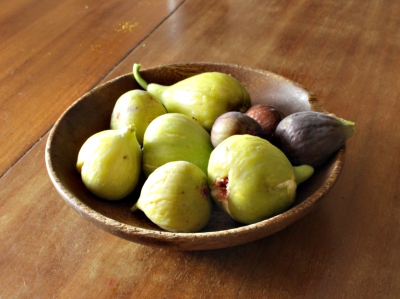TO PRUNE OR NOT TO PRUNE, THAT IS THE QUESTION
/3 Comments/in Pruning/by Lee ReichA Sharp Knife is not Enough
“Prune when the knife is sharp” goes the old saying. Wrong! (But don’t ever prune if the knife—or shears—is not sharp.) There are best times for pruning, and they depend more on the type of plant and the mode of training than on the sharpness of the knife.
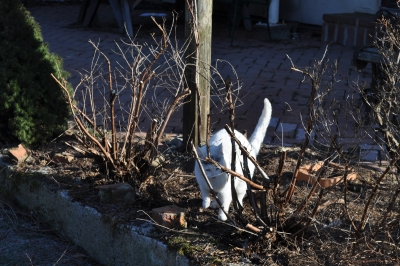
Cat is ready to prune
As each growing season draws to a close in temperate climates, trees, shrubs, and vines lay away a certain amount of food in their above- and below-ground parts. This food keeps the plants alive through winter, when they can’t use sunlight to make food because of lack of leaves (on deciduous plants) or cold temperatures. This stored food also fuels the growth of the following season’s new shoots and leaves, which, as they mature, start manufacturing their own food and pumping the excess back into the plant for use in the coming winter.
A similar situation exists in some tropical and subtropical climates having alternating wet and dry, or cool and warm, seasons. Plants must wait out those quiet times drawing on their reserves.

Old apple tree, unpruned & pruned.jpg
When you prune a dormant plant, you remove buds that would have grown into shoots or flowers. Because pruning reapportions a plant’s food reserves amongst fewer buds, the fewer remaining shoots that grow each get more “to eat” than they otherwise would have and thus grow with increased vigor.
(For more details on above and what follows, see my book, The Pruning Book, available from the usual sources or directly from me, signed, at www.leereich.com.)
Summer or Winter, Growing or Dormant?
As the growing season progresses, response to pruning changes, because shoots of woody plants cease to draw on reserves and stems stop growing longer well before leaves fall in autumn. In fact, growth commonly screeches to a halt by midsummer. So the later in the growing season that you prune, the less inclined a woody plant is to regrow — the year of pruning, at least.
Traditional theory holds that summer pruning is more dwarfing than dormant pruning, but contemporary research puts this theory on shaky footing. True, if you shorten a stem while it is dormant — in February, for example — buds that remain will begin to grow into shoots by March and April, while if you cut back a shoot in midsummer, the plant might just sit tight, unresponsive. Ah, but what about the following spring? That’s when the summer-pruned shoot, according to this recent research, waits to respond. (Plants have an amazing capacity to act however they please no matter what we do to them.)
What are the practical implications of all this? First of all, if you want to coax buds along a stem to telescope out into shoots, prune that stem when it’s dormant.

Pollarded catalpa
On the other hand, summer is the time to remove a stem to let light in among the branches (to color up ripening apples or peaches, for example), or to remove a stem that is vigorous and in the wrong place. Watersprouts, which are vigorous, vertical shoots, are less likely to regrow if snapped off before they become woody at their bases.
Under certain conditions, summer pruning can be more dwarfing than dormant pruning, because regrowth following summer pruning can be pruned again. And again. Under certain conditions, summer pruning can also prompt the formation of flower buds rather than new shoots — just what you want for solidly clothing the limbs of a pear espalier with fruits or the branches of a wisteria vine with flowers.

Pear, before and after summer pruning detail

Red currant espalier before & after summer pruning
Unfortunately, the response to summer pruning depends on the condition of the plant as well as the weather. A weak plant may be killed by summer pruning. A late summer wet spell, especially if it follows weeks of dry weather, might awaken buds that without pruning would have stayed dormant until the following spring. Also factor just how much growth you lop off a stem as well as temperatures in the days or weeks following pruning.
Whose Health?
Regrowth and flowering are the dramatic responses to pruning; you also must consider plant health when deciding when to prune. Although immediate regrowth rarely occurs after late summer or autumn pruning, cells right at the cut are stirred into activity to close off the wound. Active cells are liable to be injured by cold weather, which is a reason to avoid pruning in late summer or autumn except in climates with mild winters or with plants that are very hardy to cold.
Dormant pruning just before growth begins leaves a wound exposed for the minimum amount of time before healing begins. Some plants — peach and its relatives, for example — are so susceptible to infections at wounds that they are best pruned while in blossom. On the other hand, the correct time to prune a diseased or damaged branch is whenever you notice it.
Also consider your own health (your equanimity and your energy) when timing your pruning. Depending on the number of plants you have to prune, as well as other commitments, you may not be able to prune all your plants at each one’s optimum moment. I prune my gooseberries in autumn (they never suffer winter damage), my apples just after the most bitter winter cold has reliably move on, and my plums (a peach relative) while they are blossoming.
Sap oozes profusely from cut surfaces of maples, birches, grapes, and kiwis if they are pruned just as their buds are plumping up in spring. The way to avoid this loss of sap is to prune either in winter, when the plants are fully dormant, or in spring, after growth is underway. The sap loss actually does no harm to the plants, so rushing or delaying pruning on this account is not for your plant’s health, but so that you can rest easy.
GETTING TO THE ROOT OF GARDENING
/2 Comments/in Design, Flowers, Fruit, Gardening/by Lee ReichEtymological Wanderings
Sure, I’ve been dropping seeds into mini-furrows in some seed flats, and prunings are starting to litter the ground outdoors. But there’s a lot of nongardening activity going on here. What better time to ponder etymology? (Etymology, not entomology, the latter of which is the study of insects; aphids, mealybugs and whiteflies, all of which will be crawling around soon enough.) What exactly do we mean when we talk about a “garden” or “gardening?”
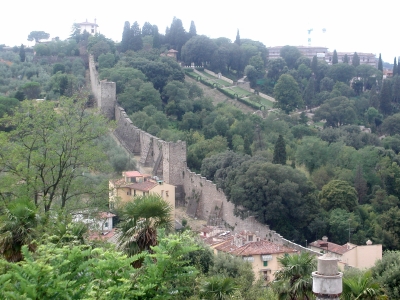
Garden(?) in Italy
The word “gardening” is pretty much synonymous with “horticulture,” which comes from the Latin hortus meaning a garden, and cultura, to culture. According to Webster, horticulture is the “art or science of cultivating fruits, flowers, and vegetables.” The word “horticulture” was given official recognition in The New World of English Words in 1678 by E. Phillips, although though the Latin form, horticultura, first appeared as the title of a treatise of 1631.
Horticulture, then, is about growing fruits, flowers, and vegetables; nothing is said about cultivating a field of cotton or wheat. These latter crops are in the ken of agronomy, from the Latin root ager meaning field. Once again quoting Webster, agronomy is the “science or art of crop production; the management of farm land.” Horticultural crops are more intensively cultivated than farm crops — and more apt to be threatened by neglect.
In fact, “gardening” and “horticulture” are not exactly synonymous. Horticulture is usually associated with growing plants for a livelihood, and is broken down into pomology (fruits), olericulture (vegetables), floriculture (flowers) and landscaping. Gardening usually implies something more homey and intimate.
Gardyne Styles
Over the centuries, the word “garden” has been penned in many spellings. A chronicler of the 13th century wrote “gardynes,” in the next century Chaucer wrote the word a bit differently: “Yif me a plante of thilke blessed tre And in my gardyn planted it shall be.” We see yet another spelling early in the sixteenth century: “My lord you have very good strawberries at your gardayne in Holberne.” Finally, by the time of Shakespeare, we have: “Ile fetch a turne about the Garden.” Here, “garden” at least, is spelt [sic] the moderne [sic] way.
The root of the word “garden” comes from the Old English geard, meaning fence, enclosure, or courtyard, and the Old Saxon gyrdan, meaning to enclose or gird.
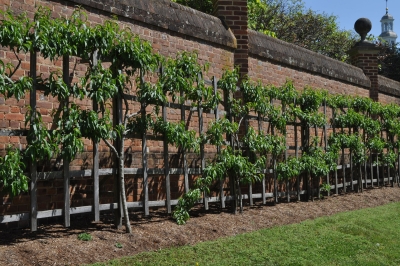
Walled garden
These words are closely related to our modern words “yard,” “girth,” and “guard.” Medieval gardens were physically enclosed. My vegetable garden is too, but mostly as protection against rabbits that love my peas and beans, not against knights practicing their jousting or wild pigs roaming the fields. The medieval garden was against the house and protected by a high wall, or, perhaps a wattle fence.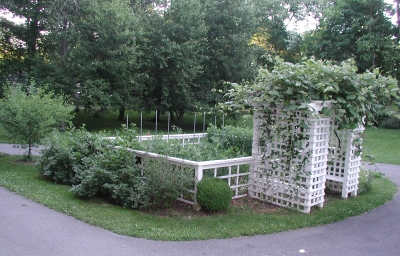
Over the centuries, “garden” and “gardening” have come to mean more than the fenced medieval garden. The archetypal Persian garden is dominated by refreshing pools or fountains of water. In the Italian garden, we find trees and shrubs, and stone stairways, balustrades, and porticos.

Classic Italian garden
Grand parterres characterize the French style of gardening.

Parterres in French garden
About a hundred years ago, the increasingly grand style of gardening fell from favor as an Englishwoman, Gertrude Jekyll, came forward to laud and design gardens that emulated intimate, colorful, and informal cottage gardens. She wrote that the ” . . . first purpose of a garden is to give happiness and repose of mind, which is more often enjoyed in the contemplation of the homely border . . . than in any of the great gardens where the flowers lose their identity, and with it their hold on the human heart.”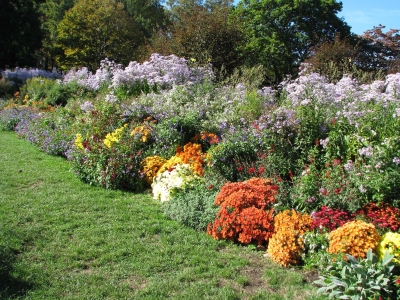
And Today . . . ?
What does “garden” and “gardening” mean today? A few tomato and marigold plants, separated from the dwelling by an expanse of lawn? A woodland glen of ferns and bleeding hearts? More recently, “forest gardens” have incorporated edible plants in forest-ish settings.

A forest garden?
How about a knot garden of herbs within a white picket fence — in the medieval style, one might say?
The World Was My Garden, the title of the book by early 20th century plant explorer and botanist David Fairchild offers another perspective on “garden.” (I’ll change the “was” to “is,” though.) I’m not sure where my garden ends and whatever else grows within my property boundaries begins.
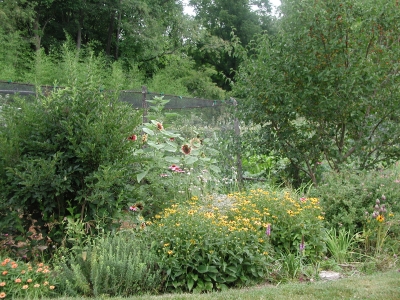
What’s the boundary of this garden?
I pick strawberries in my vegetable garden and grow Caucasian mountain spinach among my gooseberries. Grapevines clamber on the arbor over my terrace, and a stewartia tree, mountain laurels, and lowbush blueberries snuggle near the east side of my home.
And why stop at property boundaries?
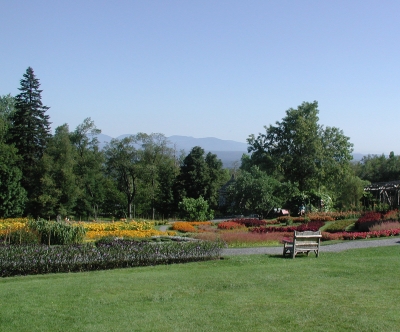
Mountains “in” this garden
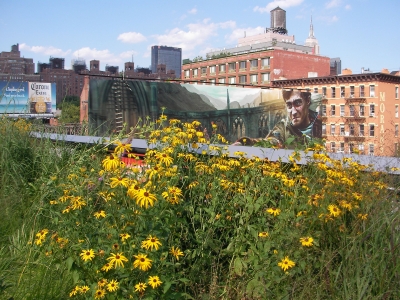
Buildings as part of this garden, NYC HIghline
A row of eighty foot tall pine trees peer over the tops of my pear trees from the far end of my neighbor’s property two houses away to the north.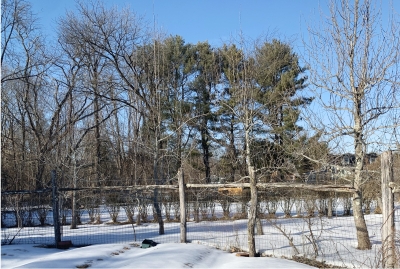 To the south my meadow ends at a sweep of another neighbor’s field, the more frequently mown grass of which undulate like waves in summer sunshine in contrast to the more upright asters, fleabanes, goldenrods, and monardas that stand upright among the grasses in my meadow.
To the south my meadow ends at a sweep of another neighbor’s field, the more frequently mown grass of which undulate like waves in summer sunshine in contrast to the more upright asters, fleabanes, goldenrods, and monardas that stand upright among the grasses in my meadow. 
Further extending the boundary are gardens revisited in my memory and those I have yet to see.

My boundless garden
FIGS: WAIT, DON’T GROW!
/17 Comments/in Gardening/by Lee ReichStay Asleep Please
If you garden in a cold winter climate, as do I, I hope you’re growing figs. Despite being tropical plants, figs are relatively easy for us to grow, as attested to by other gardeners, from Moscow to Montreal, Minneapolis and beyond.

San Piero fig, ripe
If you garden in a cold winter climate, I also hope that your fig plant is NOT growing now (unless you’re in the Southern Hemisphere). The way we cold-climate fig growers help our plants face winter cold is by protecting them from it. A usual method is to grow a plant in a pot that gets moved to a sheltered location to wait out winter. (Growing in pots plus four other methods of overwintering figs are described in my recent book Growing Figs in Cold Climates.)
Sometimes — too often — a fig jumps the gun on spring and starts growing in its sheltered location. Figs shed their leaves when they feel cold is just around the corner, so don’t need bright light in winter. But once buds awaken, they need all the light it can get.
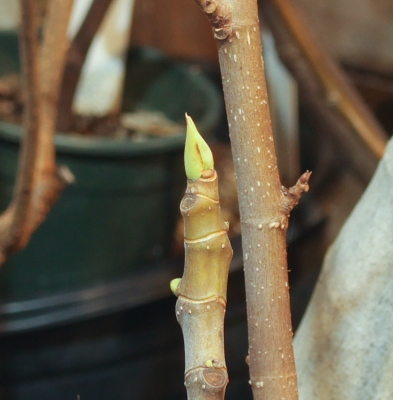
Fig starting to wake up
Don’t fool yourself that a sunny window is sufficient light. The light there typically ranges from 2,000 to 5,000 foot-candles, while full sunlight outdoors is over 10,000 foot-candles. With insufficient light, growth becomes etiolated, that is, stretched out and pale as if reaching for light. And when the time comes for the plant to move outdoors, strong sunlight and drying winds will burn those etiolated stems.
Sleep Recipes
So the goal is to retard growth until outdoor conditions are more fig-friendly. If fully dormant, the plant can tolerate temperatures down into the low 20s Fahrenheit, even colder in a large enough pot. (Cold penetrates more deeply into smaller pots, and fig roots, like those of all temperate-zone plants, can’t tolerate as much cold as stems.)
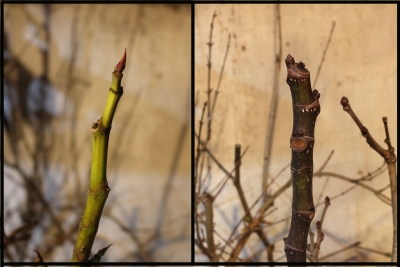
Fig stems, dormant
The ideal situation is to be able to move a fully dormant fig plant outdoors while temperatures are still cold, but not cold enough to injure the stems or roots. Then buds gradually unfurl in synch with warming temperatures and increasingly intense sunlight.
My potted plants are fully dormant, the result, all winter, of keeping the pots in a cold room with minimal watering. Ideal winter temperatures for a fig are between the high 20s and low 40s. A barely or unheated garage, a cold basement, an unheated mudroom or attic, perhaps even a shed can all keep a fig asleep long enough.
Most of my plants get watered just once in winter. I lift the pots and can tell by experience from their weight whether water is needed. A soil moisture meter probe also works. They are in humid locations, either in my basement or in a walk-in cooler. Sealing each pot and soil, not the stems, in a plastic bag could cut down or eliminate any need for water.
Only one of my potted figs has already started growing. (I let it do so for this photograph.) My one growing fig is actually doing quite well, with new growth expanding slowly and robustly.  Besides having its thirst quenched just enough to prevent wilting, it sits in front of a large, unobstructed window facing due south in a room whose temperatures range from the 50s and 60s. (That’s why I’m writing while sitting here in a down jacket!)
Besides having its thirst quenched just enough to prevent wilting, it sits in front of a large, unobstructed window facing due south in a room whose temperatures range from the 50s and 60s. (That’s why I’m writing while sitting here in a down jacket!)
Shock Treatment
Okay, so you can’t provide ideal enough conditions, and your plant is overenthusiastic about winter’s end. Give it a little shock. Potted figs do need repotting every year or two to refresh soil nutrients and give roots new room to grow. If the plant is in as large a pot as you wish, the root ball needs to be slid out of the pots and sliced back to afford space for fresh potting soil. The larger the plant, the more roots can be removed. I go around the edge of the root ball with a kitchen knife slicing an inch or two off around the edge of the root ball. That should tell Ms. Fig to chillax!
The larger the plant, the more roots can be removed. I go around the edge of the root ball with a kitchen knife slicing an inch or two off around the edge of the root ball. That should tell Ms. Fig to chillax!
Stem pruning is another way to put the brakes on growth. And figs anyway benefit from annual pruning. How much to prune depends on the bearing habit of the fig, some varieties bearing best on new growth, some on one-year-old growth, and still others on both types of growth. (I refer you to my book for details about pruning figs.)
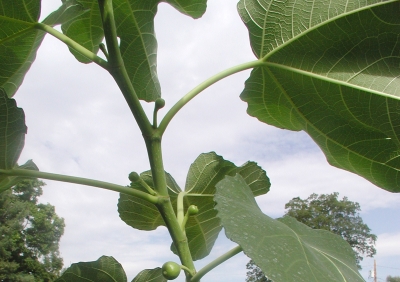
Fig fruits developing on new growth
Not to Worry
Perhaps you haven’t provided ideal winter conditions, you have no sun drenched windows, your home is warm, and you already repotted and pruned last fall. Don’t give up. Worst case scenario is that sappy, etiolated stems have emerged on your fig plant. Once outdoor temperatures moderate, you have three choices.
Gradually acclimate the plant to the great outdoors in much the same way as is done with tomato seedlings. Start the plant with a week or so in an outdoor location protected from full sunlight, wind, and freezing temperatures, moving it periodically indoors if conditions make it necessary. Gradually move it to the more exposed location of its summer home.
Second choice. Move the plant immediately to its summer home, but prune back growing stems, which, anyway, will likely burn.
Third, and easiest, choice, is to move the plant immediately to its summer home. Period. You’ll see some dieback and burning, but the plant should survive unless it’s very young or very weak.
The nice thing about growing figs, and one of the thinks that makes it possible to grow them in cold climates, is that they are very forgiving plants. More so than you might imagine.